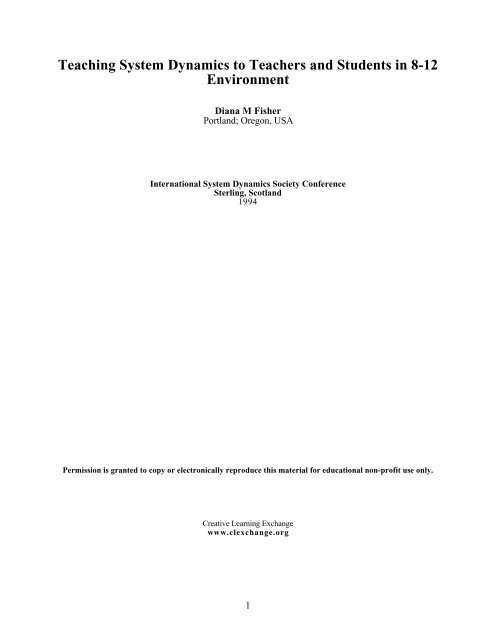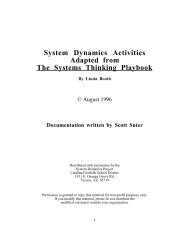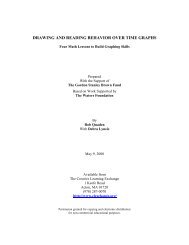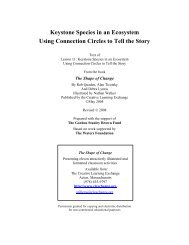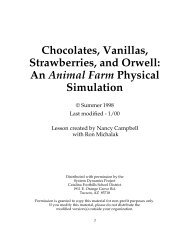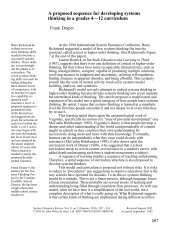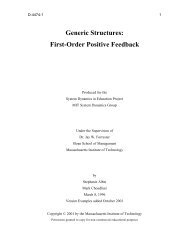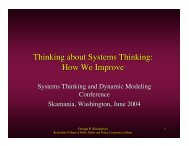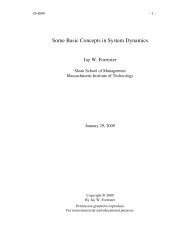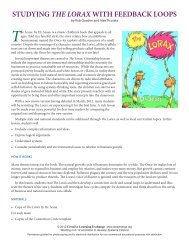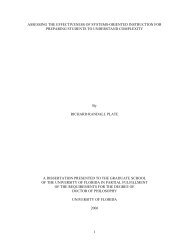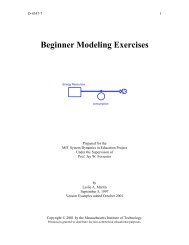Teaching System Dynamics to Teachers and Students in 8-12 ...
Teaching System Dynamics to Teachers and Students in 8-12 ...
Teaching System Dynamics to Teachers and Students in 8-12 ...
Create successful ePaper yourself
Turn your PDF publications into a flip-book with our unique Google optimized e-Paper software.
<strong>Teach<strong>in</strong>g</strong> <strong>System</strong> <strong>Dynamics</strong> <strong>to</strong> <strong>Teachers</strong> <strong>and</strong> <strong>Students</strong> <strong>in</strong> 8-<strong>12</strong>EnvironmentDiana M FisherPortl<strong>and</strong>; Oregon, USAInternational <strong>System</strong> <strong>Dynamics</strong> Society ConferenceSterl<strong>in</strong>g, Scotl<strong>and</strong>1994Permission is granted <strong>to</strong> copy or electronically reproduce this material for educational non-profit use only.Creative Learn<strong>in</strong>g Exchangewww.clexchange.org1
<strong>Teach<strong>in</strong>g</strong> <strong>System</strong> <strong>Dynamics</strong> <strong>to</strong> <strong>Teachers</strong> <strong>and</strong> <strong>Students</strong> <strong>in</strong> 8-<strong>12</strong> EnvironmentDiana M FisherAbstract<strong>System</strong> <strong>Dynamics</strong> at the pre-college level—its time has come. Enough teachers have sufficient comfort withtechnology. Tools such as STELLA II <strong>and</strong> PowerSim have provided the broad-based language forcommunication <strong>and</strong> underst<strong>and</strong><strong>in</strong>g.A recently awarded 3 year National Science Foundation grant, CC-STADUS (Cross-Curricular <strong>System</strong>Th<strong>in</strong>k<strong>in</strong>g <strong>and</strong> <strong>Dynamics</strong> Us<strong>in</strong>g STELLA) is tra<strong>in</strong><strong>in</strong>g 165 high school math, science, <strong>and</strong> social studiesteachers <strong>in</strong> system model<strong>in</strong>g us<strong>in</strong>g STELLA II. <strong>Teachers</strong> develop some models with<strong>in</strong> their curricula areas.Then cross-curricular teacher teams are formed <strong>to</strong> design at least one large model <strong>and</strong> develop curricularmaterials around the model so it can be used immediately <strong>in</strong> their classes. The tra<strong>in</strong><strong>in</strong>g is done by highschool teachers <strong>and</strong> by speakers from <strong>in</strong>dustry who use model<strong>in</strong>g <strong>in</strong> their work. The teacher participantsare responsible for shar<strong>in</strong>g their knowledge <strong>and</strong> expertise with other faculty <strong>and</strong> with students <strong>in</strong> theirclasses.High school students are us<strong>in</strong>g systems concepts at various levels. At the lower levels (especially with “atrisk”students) the teacher demonstrates how a model is designed <strong>and</strong> students manipulate the model <strong>and</strong>predict new behavior. At the middle level, students develop a model as a class activity under the directguidance of the teacher. At the highest level, students select a <strong>to</strong>pic of <strong>in</strong>terest, formulate boundaries, workwith an <strong>in</strong>formation resource person, <strong>and</strong> work with a model<strong>in</strong>g resource person <strong>to</strong> develop a model <strong>and</strong>present it <strong>to</strong> a class.Permission granted <strong>to</strong> copy for educational/non-profit use only.2
<strong>Teach<strong>in</strong>g</strong> <strong>System</strong> <strong>Dynamics</strong> <strong>to</strong> <strong>Teachers</strong> <strong>and</strong> <strong>Students</strong> <strong>in</strong> 8-<strong>12</strong> EnvironmentThis paper will present two <strong>to</strong>pics: First the details of tra<strong>in</strong><strong>in</strong>g math, science, <strong>and</strong> social studies teachers <strong>in</strong>systemic model<strong>in</strong>g dur<strong>in</strong>g a three week summer tra<strong>in</strong><strong>in</strong>g, <strong>and</strong> second, teach<strong>in</strong>g high school students <strong>to</strong> dosystemic model<strong>in</strong>g.Part I (Tra<strong>in</strong><strong>in</strong>g the teachers)On May 7, 1993, the National Science Foundation awarded fund<strong>in</strong>g <strong>to</strong> the project CC-STADUS (Cross-Curricular <strong>System</strong> Th<strong>in</strong>k<strong>in</strong>g <strong>and</strong> <strong>Dynamics</strong> Us<strong>in</strong>g STELLA). Over three years this project will tra<strong>in</strong> 165high school math, science, <strong>and</strong> social studies teachers <strong>in</strong> system model<strong>in</strong>g us<strong>in</strong>g the STELLA II softwaredeveloped by High Performance <strong>System</strong>s. The pr<strong>in</strong>cipal <strong>in</strong>vestiga<strong>to</strong>rs are: Diana M. Fisher, ProjectDirec<strong>to</strong>r (Math/Computer teacher at Frankl<strong>in</strong> High School, Portl<strong>and</strong>, Oregon, USA), Ron Zaraza (Physicsteacher at Wilson High School, Portl<strong>and</strong>, Oregon), Dr. Andrew Jonca (Professor of Mathematics withspecialty <strong>in</strong> Numerical Analysis, Pacific University, Forest Grove, Oregon), <strong>and</strong> Steve Carlson (AssistantSuper<strong>in</strong>tendent, Bla<strong>in</strong>e County Schools, Hailey, Idaho).The first summer tra<strong>in</strong><strong>in</strong>g was held at Frankl<strong>in</strong> High School <strong>in</strong> Portl<strong>and</strong>, Oregon, from July 7 <strong>to</strong> July 24,1993. Dur<strong>in</strong>g this time 36 teachers (13 <strong>in</strong> math, 13 <strong>in</strong> science, <strong>and</strong> 10 <strong>in</strong> social studies) from the Portl<strong>and</strong>metropolitan area participated <strong>in</strong> an <strong>in</strong>tensive (8am-4pm) three-week workshop. Twenty different schoolswere represented. There were eight core team presenters, of whom seven were high school teachers (2 <strong>in</strong>math—Diana Fisher, Eileen Rogers; 2 <strong>in</strong> science—Ron Zaraza, Karen Kelly; 3 <strong>in</strong> social studies—JoanKent, Jim Dyal, Patrick Murphy) <strong>and</strong> one a math professor (Dr. Andrew Jonca) from Pacific University.There were also various <strong>in</strong>dustry presenters:• Dr. Edward Gallaher, research pharmacologist, VA Hospital, <strong>and</strong> professor at Oregon Health SciencesUniversity, Portl<strong>and</strong>, Oregon (presented model of drug assimilation <strong>in</strong> the human body),• Michael Newsom, economist <strong>and</strong> mathematician, Bonneville Power Association, Portl<strong>and</strong>, Oregon(presented model of hydroelectric dam),• Dr. Gerry S<strong>to</strong>kes, Global Program Office Direc<strong>to</strong>r <strong>and</strong> Scientific Direc<strong>to</strong>r for Atmospheric RadiationMeasurement Program for the US Department of Energy (presented “Global Change <strong>and</strong> Model<strong>in</strong>g”),• Nancy Miller, senior research scientist, Battelle Labs, Richl<strong>and</strong>, Wash<strong>in</strong>g<strong>to</strong>n, (presented climatemodel<strong>in</strong>g),• Dr. George McRae, Professor of Mathematics, University of Montana, Missoula, Montana, (presenteddiscrete model<strong>in</strong>g <strong>and</strong> recurrence relations),• <strong>and</strong> a three day presentation by Steve Peterson, STELLA II co-designer, High Performance <strong>System</strong>(presented the fundamental concepts <strong>in</strong> system dynamics <strong>and</strong> the beg<strong>in</strong>n<strong>in</strong>g ideas beh<strong>in</strong>d formulat<strong>in</strong>glarger models).The goals of the workshop were <strong>to</strong> establish a rudimentary underst<strong>and</strong><strong>in</strong>g of system dynamics, familiaritywith the STELLA II software as the communication <strong>to</strong>ol, <strong>and</strong> experience <strong>in</strong> cross-curricular team dynamics,while design<strong>in</strong>g models that could be used at the high school level with students. Attempts were made, <strong>in</strong>the tra<strong>in</strong><strong>in</strong>g, <strong>to</strong> provide teachers with experiences <strong>and</strong> materials they could provide for their students. Thedesign of the entire project <strong>and</strong> all the tra<strong>in</strong><strong>in</strong>g experiences were determ<strong>in</strong>ed by teachers who are teach<strong>in</strong>g <strong>in</strong>the high school classroom. Participants must be teachers <strong>in</strong> the high school classroom.It is suggested that cross-curricular opportunities be provided for students, yet most teachers have neverhad an opportunity <strong>to</strong> learn <strong>in</strong> such an environment. They are supposed <strong>to</strong> div<strong>in</strong>e how <strong>to</strong> make thissignificant step. It is no simple feat. The project attempts <strong>to</strong> provide this environment for the teachers. Aproblem that presents itself is determ<strong>in</strong><strong>in</strong>g a way <strong>to</strong> promote communication between the discipl<strong>in</strong>es. TheSTELLA II software is a critical <strong>to</strong>ol at this po<strong>in</strong>t. It is a language that is both simple <strong>and</strong> powerful. Itsvisual nature allows <strong>in</strong>clusion of those not given <strong>to</strong> quantitative analysis. It can be used as a structuredmethod of diagramm<strong>in</strong>g <strong>in</strong> the same way as m<strong>in</strong>d maps are used <strong>in</strong> social studies. STELLA II’s multipledef<strong>in</strong>ition capability provides power <strong>to</strong> those whose expertise lies <strong>in</strong> quantitative analysis. It provides power<strong>to</strong> def<strong>in</strong>e a system <strong>in</strong> as mathematically rigorous a fashion as the traditional equation(s) def<strong>in</strong>ition.3
STELLA II’s visual nature allows the user <strong>to</strong> conceptually dist<strong>in</strong>guish between quantities vary<strong>in</strong>g <strong>in</strong> time<strong>and</strong> their rates of change. It furnishes <strong>to</strong> the model<strong>in</strong>g environment three essential components.The first is afford<strong>in</strong>g the ability <strong>to</strong> visualize the functional relationships, show<strong>in</strong>g clearly what componentsdepend upon what other components This evolves dur<strong>in</strong>g the design of the diagram. It is referred <strong>to</strong> as“lay<strong>in</strong>g out the plumb<strong>in</strong>g” <strong>in</strong> the STELLA II manual. The second is supply<strong>in</strong>g the mathematical rigor bydef<strong>in</strong><strong>in</strong>g the dynamics beh<strong>in</strong>d each component of the functional relationships. The third is requir<strong>in</strong>g thedesigner <strong>to</strong> clearly specify the set of <strong>in</strong>itial parameters that determ<strong>in</strong>e the <strong>in</strong>itial state of the system. Theseare not trivial issues <strong>in</strong> model<strong>in</strong>g, especially at the high school level.For a cross-curricular effort <strong>in</strong>clusion is the key term. Were it not for the STELLA II (<strong>and</strong> similar)software, there would not have been the possibility of br<strong>in</strong>g<strong>in</strong>g system dynamics <strong>and</strong> cross-curricularproblem solv<strong>in</strong>g <strong>to</strong> the high school level. Inclusion—the chance <strong>to</strong> br<strong>in</strong>g <strong>in</strong> those discipl<strong>in</strong>es where the trulysignificant problems lie, social studies (policy mak<strong>in</strong>g); <strong>in</strong>clusion—the chance <strong>to</strong> br<strong>in</strong>g <strong>in</strong> those studentswho have been excluded from mathematical power due <strong>to</strong> the equation <strong>in</strong>terface for solv<strong>in</strong>g problems. (Inthe twenty-five years I have been teach<strong>in</strong>g I have never encountered the potential for change that is moresignificant than a systemic approach <strong>to</strong> problem solv<strong>in</strong>g us<strong>in</strong>g a visual <strong>to</strong>ol that <strong>in</strong>cludes more players <strong>in</strong> theprocess. This is a crossroads, an evolutionary leap <strong>in</strong> our ability <strong>to</strong> address significant problems at the highschool level. It is a great time <strong>to</strong> be a teacher.)The tra<strong>in</strong><strong>in</strong>g takes place over three weeks. The first week an activity is presented that provides thegroundwork for the cross-curricular nature of the tra<strong>in</strong><strong>in</strong>g. The participants work through the Fishbanks 2simulation. This is an exercise <strong>in</strong> which the participants form groups, each of which is the board ofdirec<strong>to</strong>rs of a fish company. Each group's goal is <strong>to</strong> maximize its assets over a simulated 10 years offish<strong>in</strong>g. The companies make decisions about the number of ships <strong>to</strong> buy <strong>and</strong> where <strong>to</strong> send those ships <strong>in</strong>the hope of obta<strong>in</strong><strong>in</strong>g an optimal number of fish, which are subsequently sold. Dur<strong>in</strong>g the course of theactivity, problems arise that must be dealt with. The companies can deal with the problems <strong>in</strong>dividually orcollectively. How the problems are solved determ<strong>in</strong>es the outcome of the simulation. After the activity, thedynamics of the behaviors are analyzed, <strong>and</strong> real-world situations are presented that were similar <strong>in</strong> nature<strong>to</strong> the problems that occurred <strong>in</strong> the simulation. Discussion then ensues on the potential alternativesolutions that could have been chosen. This discussion <strong>in</strong>cludes scientific data that could have beencollected <strong>and</strong> policy decisions that could have been made. At the end of the first week a STELLA IIFishbanks 3 model, developed at MIT, of this simulation is presented <strong>and</strong> the teachers (on the computer)work through different policy decisions <strong>to</strong> see if the outcome could be altered.Before the teachers can use the STELLA II Fishbanks model, they need <strong>to</strong> learn <strong>to</strong> use the STELLA IIsoftware. The middle of the first week is dedicated <strong>to</strong> <strong>in</strong>troduc<strong>in</strong>g the software <strong>in</strong> a segregated environment(i.e., the math teachers <strong>in</strong> one room, the science teachers <strong>in</strong> another, <strong>and</strong> the social studies teachers <strong>in</strong> athird). The reasons for this are: First, when <strong>in</strong>troduc<strong>in</strong>g a new approach <strong>to</strong> solv<strong>in</strong>g problems, it was felt thata connection <strong>to</strong> the teachers’ area of strength was important. With<strong>in</strong> their comfort zone they are better able<strong>to</strong> h<strong>and</strong>le someth<strong>in</strong>g new. Secondly, <strong>in</strong> order <strong>to</strong> obta<strong>in</strong> commitment <strong>to</strong> a new approach, it is beater <strong>to</strong> allowteachers <strong>to</strong> see how it is relevant <strong>and</strong> useful with<strong>in</strong> their curricular area. They can see how <strong>to</strong> approach someof the <strong>to</strong>pics they currently teach <strong>in</strong> an alternate way. Thirdly, <strong>in</strong> the last week, when there will becross-curricular teams, the teachers will have <strong>to</strong> be will<strong>in</strong>g <strong>to</strong> give up some of their own immediateapplication for the good of the team effort. With all the materials <strong>and</strong> models the teachers develop <strong>in</strong> thefirst week which are directly related <strong>to</strong> their curricular area, they are more will<strong>in</strong>g <strong>to</strong> work on tasks dur<strong>in</strong>gthe third week which may benefit their classes <strong>in</strong>directly.So, the majority of the first week is spend <strong>in</strong> segregated curricular work, the math core team teachersteach<strong>in</strong>g the math teachers, the science core team teachers teach<strong>in</strong>g the science teachers, <strong>and</strong> the socialstudies core team teachers work<strong>in</strong>g with the social studies teachers. Topics <strong>and</strong> materials are those used bythe tra<strong>in</strong>ers <strong>in</strong> actual high school classes. The only difficulty dur<strong>in</strong>g the first week of the tra<strong>in</strong><strong>in</strong>g was forthose participants who were not Mac<strong>in</strong><strong>to</strong>sh computer literate. It was not overwhelm<strong>in</strong>g, but it did createsome additional obstacles for those few teachers.4
The second week brought <strong>in</strong> the <strong>in</strong>dustry experts. Each expert presented his/her <strong>to</strong>pic <strong>and</strong> providedh<strong>and</strong>s-on exercises for the teachers. It was <strong>in</strong>tended that each expert present <strong>in</strong> 1 <strong>to</strong> 1.5 hour blocks <strong>and</strong>provide 1 hour of h<strong>and</strong>s-on activities <strong>in</strong> between. This did not always occur. Some persons lectured longerthan 1.5 hours, frustrat<strong>in</strong>g the teachers. For the summer of 1994, the importance of h<strong>and</strong>s-on exercises forthe teachers has been reemphasized <strong>to</strong> the speakers.Dur<strong>in</strong>g the third week, there was still an occasional speaker (early <strong>in</strong> the week) but the majority of the weekwas spent <strong>in</strong> list<strong>in</strong>g <strong>to</strong>pics for models (participants determ<strong>in</strong>ed the <strong>to</strong>pics), choos<strong>in</strong>g teams <strong>to</strong> work on agiven model, <strong>and</strong> design<strong>in</strong>g a work<strong>in</strong>g model with support<strong>in</strong>g curricular material. A surpris<strong>in</strong>g phenomenonoccurred. Early <strong>in</strong> the tra<strong>in</strong><strong>in</strong>g a special effort was made <strong>to</strong> help the social studies teachers feel compatiblewith this new system dynamics model<strong>in</strong>g concept <strong>and</strong> the use of the STELLA II software. The socialstudies teachers adapted better than anticipated. At this po<strong>in</strong>t the trouble arose with the math teachers. Theywere hesitant <strong>to</strong> jo<strong>in</strong> cross-curricular teams. This came as a surprise. They were reluctant <strong>to</strong> work out oftheir curricula area. The <strong>to</strong>pics were not of a mathematical nature, <strong>in</strong> the sense that they would not fit <strong>in</strong><strong>to</strong> atraditional math class. The math teachers wanted <strong>to</strong> do more models that would apply directly <strong>to</strong> theirclasses. It was necessary <strong>to</strong> discuss the nature of team efforts <strong>and</strong> cross-curricular projects. It was restatedthat <strong>in</strong> the world most systemic model<strong>in</strong>g <strong>to</strong>pics arise <strong>in</strong> the science <strong>and</strong>/or social science (policy decision)area. It is natural that those <strong>to</strong>pics were the ones listed by the group. In the group effort, the social studiesor science teacher was <strong>to</strong> expla<strong>in</strong> the fundamental components of the model <strong>and</strong> how they <strong>in</strong>terrelated.She/he would also be responsible for describ<strong>in</strong>g the behavior of the system as the model<strong>in</strong>g processunfolds. It was the responsibility of the math teacher <strong>to</strong> translate that behavior <strong>to</strong> the correct underly<strong>in</strong>gmathematical def<strong>in</strong>ition <strong>to</strong> get the model <strong>to</strong> work correctly. In a sense the science/social studies teachersdef<strong>in</strong>ed the problem, <strong>and</strong> the math teachers made it work. This was a new role for the math teachers. Thoseleaders among the math participants were will<strong>in</strong>g <strong>to</strong> do this after a discussion, <strong>and</strong> the others followed,albeit still reluctantly. For the second summer tra<strong>in</strong><strong>in</strong>g, it will be necessary <strong>to</strong> establish this roleresponsibility early on so there are no false expectations. In the end, the math teachers found, for the mostpart, the exercise as participants of the model<strong>in</strong>g team <strong>in</strong>terest<strong>in</strong>g <strong>and</strong> useful. It was <strong>in</strong>terest<strong>in</strong>g <strong>to</strong> watch thedialogue between members as the models evolved. The math teachers certa<strong>in</strong>ly were a critical part of themodel<strong>in</strong>g process. Even though they could use only parts of the f<strong>in</strong>al models <strong>in</strong> their classes, the experiencewas useful.Some of the responses by the summer participants: “It was great <strong>to</strong> work closely with people from otherdiscipl<strong>in</strong>es.” “Outst<strong>and</strong><strong>in</strong>g course, a great opportunity <strong>to</strong> work <strong>in</strong> a cross-curricular group <strong>and</strong> havesometh<strong>in</strong>g concrete <strong>to</strong> br<strong>in</strong>g back <strong>to</strong> my class <strong>and</strong> my colleagues.” The best th<strong>in</strong>g about the course was“the variety of <strong>in</strong>formation <strong>and</strong> the opportunity <strong>to</strong> work with other teachers not <strong>in</strong> my area.” “...do<strong>in</strong>g thegroup project.” “Work<strong>in</strong>g <strong>to</strong>gether <strong>in</strong> an <strong>in</strong>terdiscipl<strong>in</strong>ary way.” “Gett<strong>in</strong>g <strong>to</strong> work <strong>in</strong> teams of 2-4 withother teachers...” “Most challeng<strong>in</strong>g <strong>and</strong> excit<strong>in</strong>g th<strong>in</strong>g that I've done <strong>in</strong> 25 years of teach<strong>in</strong>g. I wish Icould say <strong>in</strong> tra<strong>in</strong><strong>in</strong>g for 3 more weeks.” “...this has been the most challeng<strong>in</strong>g <strong>and</strong> reward<strong>in</strong>g workshopthat I have ever attended...” “Great stuff. Another week for work<strong>in</strong>g <strong>in</strong> cross-curricular teams <strong>and</strong> it wouldhave been perfect.”The models developed by the participants were reviewed by Dr. Andrew Jonca <strong>and</strong> Ron Zaraza. It is<strong>in</strong>tended that these models be made available <strong>to</strong> other teachers <strong>in</strong> the future. As Dr. Jonca reviewed themodels he made certa<strong>in</strong> observations that will be <strong>in</strong>corporated <strong>in</strong><strong>to</strong> the guidel<strong>in</strong>es for model developmentfor the two subsequent summer tra<strong>in</strong><strong>in</strong>g sessions. Although the models were well documented there wasone subtle omission. The most critical change Dr. Jonca suggested was requir<strong>in</strong>g more documentationabout why the modelers chose the particular components that were ultimately <strong>in</strong>cluded <strong>in</strong> the f<strong>in</strong>al model. Ifother teachers are <strong>to</strong> be able <strong>to</strong> use the models be<strong>in</strong>g developed it must be clear <strong>to</strong> others why certa<strong>in</strong>decisions were made. Dr. Jonca also produced the first sixty pages of a potential book for high schoolmath teachers entitled “Math Beh<strong>in</strong>d STELLA,” used <strong>in</strong> the summer tra<strong>in</strong><strong>in</strong>g sessions. In this book he<strong>in</strong>troduces the necessary basic concepts of derivative, antiderivative, differential equations, Euler’s Methodvs. Runge-Kutta methods of <strong>in</strong>tegration, <strong>and</strong> stability, among other very important <strong>to</strong>pics. It is <strong>in</strong>tended thatthis book be f<strong>in</strong>ished over the course of the three year grant <strong>and</strong> also made available.5
Currently negotiations are tak<strong>in</strong>g place with a commercial publisher. If the publisher decides that thematerials are not commercially viable another avenue for dissem<strong>in</strong>ation will be determ<strong>in</strong>ed. The project PI’sfeel strongly that the materials produced by this project must be made available <strong>to</strong> other teachers. It is theonly way system dynamics will ga<strong>in</strong> a foothold at the pre-college level. Tra<strong>in</strong><strong>in</strong>g teachers is not enough.There needs <strong>to</strong> be a reservoir of material for teachers who want <strong>to</strong> <strong>in</strong>corporate a systems approach <strong>in</strong> theirclassroom. The Creative Learn<strong>in</strong>g Exchange is a start, but it needs the support of all projects <strong>in</strong>volv<strong>in</strong>gsystem dynamics at the precollege level.The participants from the summer CC-STADUS tra<strong>in</strong><strong>in</strong>g requested monthly meet<strong>in</strong>gs dur<strong>in</strong>g thesubsequent school year. They had the responsibility <strong>to</strong> use system dynamics <strong>in</strong> at least two of their classesdur<strong>in</strong>g the year, <strong>to</strong> present what they learned <strong>in</strong> the summer workshop <strong>to</strong> the faculty at their school, <strong>and</strong> <strong>to</strong>design at least one additional model <strong>to</strong> be sent <strong>to</strong> the project PI’s dur<strong>in</strong>g the year. The 5 core team memberswho where not PI’s each chose 7 participants <strong>to</strong> support <strong>and</strong> evaluate. They were <strong>to</strong> visit the participant’sclass once <strong>to</strong> observe the use of system dynamics <strong>in</strong> the classroom. This is work<strong>in</strong>g out well. It isnecessary <strong>to</strong> have this level of accountability so the teacher does not go through the whole school yearwithout apply<strong>in</strong>g what was learned. In addition, the Northwest Regional Labora<strong>to</strong>ry is the official evaluationgroup for the project. They are <strong>in</strong>terview<strong>in</strong>g the participants, tra<strong>in</strong>ers, <strong>and</strong> <strong>in</strong>dustry partners <strong>and</strong> observ<strong>in</strong>gclasses <strong>in</strong> order <strong>to</strong> write a summary report.The evaluations of the first summer have been very positive. The second summer applicants were acceptedfrom around Oregon outside the Portl<strong>and</strong> metropolitan area. The third summer applicants will be acceptedfrom around the Northwestem United States.At this po<strong>in</strong>t “at-risk” students have not been addressed. The CC-STADUS grant will provide tra<strong>in</strong><strong>in</strong>g forteachers of “at-risk” students <strong>in</strong> the second summer of tra<strong>in</strong><strong>in</strong>g. There will be a two day workshop, heldbefore the three week workshop, <strong>to</strong> address system behavior activities with these students <strong>and</strong> providerecommendations <strong>and</strong> materials for that student group. Ron Zaraza will provide the tra<strong>in</strong><strong>in</strong>g. He has alreadyused system ideas <strong>in</strong> his lowest level physical science class, a class with mostly special education studentsor students identified as at-risk for other reasons. That class participated <strong>in</strong> the Fishbanks simulationactivity. They were then given the STELLA Fishbanks model <strong>and</strong> asked <strong>to</strong> manipulate the parameters <strong>in</strong>order <strong>to</strong> ma<strong>in</strong>ta<strong>in</strong> a stable fish population <strong>and</strong> keep the fishermen <strong>in</strong> bus<strong>in</strong>ess. While the students were notable <strong>to</strong> make the modifications on their own, they were able <strong>to</strong> identity key fac<strong>to</strong>rs that would affect thefisheries <strong>and</strong> cause changes. Runn<strong>in</strong>g the model with their suggested changes, Ron was able <strong>to</strong> engagethem <strong>in</strong> lengthy discussions about cause <strong>and</strong> effect <strong>in</strong> the fisheries. <strong>Students</strong> used a number of problemsolv<strong>in</strong>g strategies <strong>to</strong> try <strong>to</strong> develop self susta<strong>in</strong><strong>in</strong>g fisheries.After this <strong>in</strong>itial activity, STELLA II was used <strong>in</strong> other areas of the course as well. One activity common <strong>to</strong>the low level classes <strong>and</strong> higher ability classes is graph <strong>in</strong>terpretation. Us<strong>in</strong>g simple STELLA II models,students were <strong>in</strong>troduced <strong>to</strong> the basic graph structures (L<strong>in</strong>ear, quadratic, exponential <strong>and</strong> <strong>in</strong>verse). Theywere then asked <strong>to</strong> describe the relationships between variables not modeled by look<strong>in</strong>g at graphs. Some ofthese relationships were later modeled us<strong>in</strong>g STELLA II <strong>in</strong> an all class activity. <strong>Students</strong> were also asked <strong>to</strong>come up with other relationships that fit the graphs.STELLA II, used <strong>in</strong> conjunction with an ultrasonic motion detec<strong>to</strong>r, was used <strong>to</strong> teach the students aboutk<strong>in</strong>ematics <strong>and</strong> dynamics. These <strong>to</strong>pics are not normally gone <strong>in</strong><strong>to</strong> <strong>in</strong> much depth <strong>in</strong> low level physicalscience classes because the students do not possess the mathematical <strong>to</strong>ols <strong>to</strong> deal with them. Thegraphic/conceptual approach made possible by STELLA II allowed these students <strong>to</strong> attempt <strong>and</strong>underst<strong>and</strong> sophisticated problems they would not normally have seen. After test<strong>in</strong>g these approaches withthe physical science students, they became part of the regular conceptual physics curriculum as well.6
Part II (Tra<strong>in</strong><strong>in</strong>g the students)The first part of this section will present those activities used <strong>in</strong> a high school model<strong>in</strong>g class. Thesecond will present those activities used <strong>in</strong> a second year algebra class at the high school level.In the school year 1992-93, Frankl<strong>in</strong> High School provided its first course <strong>in</strong> “Mathematical Model<strong>in</strong>gUs<strong>in</strong>g Computers.” It was a one semester course. Prerequisites were concurrent enrollment <strong>in</strong> a secondyear algebra course or above, or teacher approval. Two of the students who participated <strong>in</strong> this first classhad never taken, nor did they plan <strong>to</strong> take, second year algebra. They successfully completed the course.The content of the course was: 4-5 weeks on data analysis/curve-fitt<strong>in</strong>g techniques <strong>and</strong> error analysis<strong>and</strong> the rest of the time on system dynamics us<strong>in</strong>g STELLA II. Dur<strong>in</strong>g the system dynamics section,students were provided exercises <strong>in</strong> creat<strong>in</strong>g simple generic models as specified <strong>in</strong> the STELLA IIUser’s Guide manual (an excellent resource). They were also given examples of models of larger scope(Fishbanks model, Easter Isl<strong>and</strong> model) <strong>and</strong> activities culm<strong>in</strong>at<strong>in</strong>g <strong>in</strong> the design of a drug assimilationmodel. Dur<strong>in</strong>g the last three weeks of the course students were <strong>to</strong> design, document <strong>and</strong> write a shortpaper on a model of their choice. The students worked <strong>in</strong> teams. It was an excit<strong>in</strong>g time for all. It wasnecessary for the students <strong>to</strong> have a resource person who was responsible for expla<strong>in</strong><strong>in</strong>g the behavior<strong>in</strong>herent <strong>in</strong> the <strong>to</strong>pic under study. Those teachers/resource persons would help the student with thechoice of components upon which <strong>to</strong> focus. They also were <strong>to</strong> assist <strong>in</strong> overcom<strong>in</strong>g any misconceptions<strong>in</strong> the <strong>in</strong>teractions between components <strong>in</strong> the system. Some of the resource persons knew STELLA II<strong>and</strong> some did not. The resource person was not always able <strong>to</strong> provide the data for the models. Dur<strong>in</strong>gthis process a significant problem arose that was not anticipated. It was difficult f<strong>in</strong>d<strong>in</strong>g the data forsome of the models. As schools become connected <strong>to</strong> the Internet <strong>and</strong> as teachers make connections withmore persons outside of education will<strong>in</strong>g <strong>to</strong> work with students as resource persons, this problem willbe resolved (somewhat). At this po<strong>in</strong>t, however, it is still a significant problem. Neither the school nor thepublic libraries are or will be sufficient <strong>to</strong> serve the students’ needs <strong>in</strong> this endeavor.In the year 1993-94, the model<strong>in</strong>g class at Frankl<strong>in</strong> High School was extended <strong>to</strong> a year. The first 4-5weeks are still spent on data analysis. The rest of the year is dedicated <strong>to</strong> system dynamics us<strong>in</strong>g STELLAII. Exercises given <strong>in</strong> the previous year were aga<strong>in</strong> presented, with the addition of a demonstration of theHamlet model designed by Pam Hopk<strong>in</strong>s, an English teacher <strong>in</strong> Tucson, Arizona. Also, Dr. Andrew Joncapresented concepts from Physics, Economics, <strong>and</strong> Biology us<strong>in</strong>g STELLA <strong>and</strong> traditional mathematics.The majority of the second semester was dedicated <strong>to</strong> projects. <strong>Students</strong> were <strong>to</strong> get <strong>in</strong><strong>to</strong> groups of two orthree, choose a <strong>to</strong>pic, f<strong>in</strong>d a resource person, collect the data needed, design <strong>and</strong> document their model, writea short paper expla<strong>in</strong><strong>in</strong>g the model <strong>and</strong> their assumptions, <strong>and</strong> make at least one presentation <strong>to</strong> the rest ofthe class. <strong>Students</strong> dissolve <strong>and</strong> reassemble teams throughout the second semester as projects conclude <strong>and</strong>new ones beg<strong>in</strong>. The objective is <strong>to</strong> take the students through the entire process of model<strong>in</strong>g so they can be<strong>in</strong>dependent by the end of the year, able <strong>to</strong> underst<strong>and</strong> what is reasonable <strong>to</strong> model, how <strong>to</strong> makeassumptions, how <strong>to</strong> determ<strong>in</strong>e the variables <strong>to</strong> <strong>in</strong>clude, how <strong>to</strong> create <strong>and</strong> ref<strong>in</strong>e a model <strong>and</strong>, mostimportant, how <strong>to</strong> expla<strong>in</strong> the model <strong>to</strong> others. This process was reasonably successful the first year(reasonably, because 3 weeks proved <strong>to</strong> be <strong>to</strong>o short a time frame <strong>to</strong> accomplish all goals—but <strong>in</strong>dicatedthey could be accomplished). The second year has already shown a significant improvement over the firstyear <strong>in</strong> student <strong>and</strong> teacher read<strong>in</strong>ess.When <strong>in</strong>corporat<strong>in</strong>g the ideas of system dynamics <strong>in</strong><strong>to</strong> a second year algebra class the problems amentirely different from a model<strong>in</strong>g class. In a second year algebra class there is very little space for new<strong>to</strong>pics. The curriculum is packed with <strong>to</strong>pics that are supposed <strong>to</strong> be covered. So the first task was <strong>to</strong>determ<strong>in</strong>e what <strong>to</strong> throw out. Actually this turned out <strong>to</strong> be less difficult than anticipated. Guidance camefrom the NCTM st<strong>and</strong>ards <strong>and</strong> from a chang<strong>in</strong>g perspective about how <strong>to</strong> teach the course from a systemviewpo<strong>in</strong>t. The changes at this po<strong>in</strong>t appear <strong>to</strong> be m<strong>in</strong>imal, <strong>in</strong> the sense that most of the time the courseappears <strong>to</strong> be follow<strong>in</strong>g most of the traditional <strong>to</strong>pics. However, the emphasis, the view from which the<strong>to</strong>pics are <strong>in</strong>troduced, is different, <strong>and</strong> the word problems are supplemented with STELLA assignments.The focus is on how th<strong>in</strong>gs grow, <strong>and</strong> how that growth pattern differentiates one outcome from another. Anultrasonic motion detec<strong>to</strong>r is used <strong>to</strong> <strong>in</strong>troduce some of the growth patterns—how different motions7
produce different graphs. Then a STELLA diagram is designed <strong>to</strong> def<strong>in</strong>e the given motion. This gives thestudents a visual description of the growth pattern. From the STELLA diagram the equation is developed.Then the usual exercises <strong>in</strong> equation manipulation follow. When the word problems arise, they are def<strong>in</strong>edus<strong>in</strong>g the equation approach <strong>and</strong>/or the STELLA diagram approach. F<strong>in</strong>ally, experiments are conducted ordata provided 50 students can determ<strong>in</strong>e an equation for a growth pattern where the numbers do not workout neatly. In this case data analysis (curve fitt<strong>in</strong>g) techniques are used. This strategy works well for thetraditional <strong>to</strong>pics <strong>in</strong> second year algebra—l<strong>in</strong>ear growth, quadratic growth, exponential growth, <strong>and</strong>oscillation. It has been evident that the <strong>in</strong>clusion of STELLA has provided students another way <strong>to</strong>underst<strong>and</strong> these growth patterns. In fact, when a reference <strong>to</strong> a previous growth pattern has been made,students <strong>in</strong>variably recall the STELLA diagram before the equation <strong>in</strong> order <strong>to</strong> describe it <strong>Students</strong> oftraditionally lesser ability have commented on the ease of underst<strong>and</strong><strong>in</strong>g the STELLA diagrams <strong>and</strong> havecompla<strong>in</strong>ed that they are not used more often. The <strong>in</strong>clusion of a more systemic approach <strong>and</strong> the use ofSTELLA diagrams <strong>in</strong> the def<strong>in</strong>ition of the traditional growth patterns has enhanced the learn<strong>in</strong>gsignificantly <strong>and</strong> required only about 15 class periods <strong>in</strong> the school year.Data was collected last year on the number of (non-honors) second year algebra students who elected <strong>to</strong>take another year of mathematics. The students from the traditional (non-honors) second year algebraclasses were compared <strong>to</strong> the students from the (non-honors) second year algebra class us<strong>in</strong>g STELLA.From the class us<strong>in</strong>g STELLA 78.9% of the students went on <strong>to</strong> take another math class, compared <strong>to</strong>60.6% for all the other non-honors second year algebra classes. (<strong>Students</strong> go<strong>in</strong>g on <strong>to</strong> take another mathclass were identified as those students who had successfully completed the first semester of pre-calculus ormath model<strong>in</strong>g the subsequent year. Note: Second year algebra is the term<strong>in</strong>al math class required forcollege admission.)It is apparent that many of the growth pattern approaches used <strong>in</strong> the second year algebra class could easilybe <strong>in</strong>corporated <strong>in</strong><strong>to</strong> a first year algebra class. If <strong>and</strong> when this occurs, the second year algebra classescould start <strong>to</strong> study some of the more sophisticated growth patterns fundamental <strong>in</strong> system dynamics.When this occurs more <strong>in</strong>terest<strong>in</strong>g <strong>and</strong> realistic problems could be addressed. Eventually, it would beuseful <strong>to</strong> <strong>in</strong>troduce the traditional growth patterns from a project perspective, similar <strong>to</strong> the work done byFrank Draper <strong>in</strong> 7th/8th grade science <strong>in</strong> the Catal<strong>in</strong>a Foothills School District <strong>in</strong> Tucson, Arizona. Oncethe second year algebra class has evolved <strong>to</strong> this po<strong>in</strong>t it could be counted as truly approach<strong>in</strong>g algebrafrom a system dynamics perspective. It is important, however, not <strong>to</strong> throw out the necessary skilldevelopment <strong>in</strong> the effort <strong>to</strong> br<strong>in</strong>g <strong>in</strong> the project approach. Consequently the process is still evolv<strong>in</strong>g. Asmore teachers become facile with the system approach <strong>to</strong> solv<strong>in</strong>g problems more material will be available<strong>to</strong> meet the needs of teachers <strong>in</strong> diverse environments.Ron Zaraza has used the STELLA II software <strong>in</strong> his physics classes. He has had his advanced placementphysics students design models <strong>to</strong> address the more difficult problems <strong>in</strong> the regular physics book so thatthose students who have difficulty underst<strong>and</strong><strong>in</strong>g the material/problems us<strong>in</strong>g a traditional approach mayhave an alternate way <strong>to</strong> view <strong>and</strong> <strong>in</strong>teract with the phenomenon under study. To prepare them for that useof STELLA II, the basics of STELLA II model<strong>in</strong>g as applied <strong>to</strong> motion were part of the lab activities <strong>in</strong> theadvanced placement course. STELLA II is also used <strong>in</strong> the course <strong>to</strong> present new ideas <strong>and</strong> <strong>to</strong> addressproblems which cannot be solved with the mathematics used <strong>in</strong> the course (pre-calculus level).In regular physics classes, STELLA II is used as part of a “cafeteria” approach <strong>to</strong> teach<strong>in</strong>g. Most <strong>to</strong>picsare taught several different ways <strong>to</strong> <strong>in</strong>crease the probability that one approach works with students.STELLA II, with its visual approach, is one more way <strong>to</strong> present ideas. It is not the primary approach, bu<strong>to</strong>ne of several which, when taken as a group, serve the needs of virtually all students.A quote attributed <strong>to</strong> Albert E<strong>in</strong>ste<strong>in</strong> epi<strong>to</strong>mizes the underly<strong>in</strong>g approach <strong>to</strong> system dynamics stressed bythis project, “Everyth<strong>in</strong>g should be as simple as possible, but no simpler.”8
Notes1. National Council of <strong>Teachers</strong> of Mathematics St<strong>and</strong>ards (mak<strong>in</strong>g connections/conceptualunderst<strong>and</strong><strong>in</strong>g), Project 2061 Science St<strong>and</strong>ards (conceptual underst<strong>and</strong><strong>in</strong>g/view<strong>in</strong>g problems aswholes), <strong>and</strong> the National Council for the Social Studies (<strong>in</strong>clud<strong>in</strong>g more new technologies that addressthe <strong>in</strong>quiry process more effectively).2. Fishbanks Simulation is produced by IPSSR, Hood House, University of New Hampshire, Durham,NH 03824.3. Fishbanks STELLA II simulation is available from The Creative Learn<strong>in</strong>g Exchange, Lees Stuntz,Direc<strong>to</strong>r, 1 Keefe Road, Ac<strong>to</strong>n, MA 01720.ReferencesForrester, J. W. 1971. Pr<strong>in</strong>ciples of <strong>System</strong>s. Portl<strong>and</strong>, OR: Productivity Press_______. 1973. World <strong>Dynamics</strong>. Portl<strong>and</strong>, OR: Productivity Press.Goodman, M. R. 1983. Study Notes <strong>in</strong> <strong>System</strong> <strong>Dynamics</strong>. Portl<strong>and</strong>, OR: Productivity Press.Kauffman, D. L., Jr. 1980. <strong>System</strong>s 1. An Introduction <strong>to</strong> <strong>System</strong>s Th<strong>in</strong>k<strong>in</strong>g. Cambridge, MA: PegasusCommunications.Meadows, D. H., D. L. Meadows, <strong>and</strong> J. R<strong>and</strong>ers 1992. Beyond The Limits. Cambridge, MA: PegasusCommunications.Meadows, D. H. 1991. The Global Citizen. Cambridge, MA: Pegasus Communications.Richmond, B., <strong>and</strong> S. Peterson. 1993. STELLA II: An Introduction <strong>to</strong> <strong>System</strong>s Th<strong>in</strong>k<strong>in</strong>g. HighPerformance <strong>System</strong>s, 45 Lyme Road, Hanover, NH 03755 USA_______. 1993. STELLA II Applications. High Performance <strong>System</strong>s, 4S Lyme Road, Hanover N H03755, USARoberts, N., D. Anderson, R. Deal, M. Garet, <strong>and</strong> W. Shaffer. 1983. Introduction <strong>to</strong> Computer Simulation:A <strong>System</strong> <strong>Dynamics</strong> Approach. Portl<strong>and</strong>, OR: Productivity Press.Senge, P. M. 1990. The Fifth Discipl<strong>in</strong>e. New York: Doubleday.Stuntz, L. Direc<strong>to</strong>r, Creative Learn<strong>in</strong>g Exchange, 1 Keefe Road, Ac<strong>to</strong>n, MA 01720. USA9


